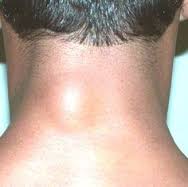
Hormone therapies can block estrogen receptors or lower estrogen levels. Your doctor may suggest chemotherapy when there’s lymph node involvement or if there’s a chance that cancer has spread beyond the lymph nodes.Ĭhemotherapy may be a good choice in very aggressive cancers or those that are negative for hormone and HER2 receptors. ChemotherapyĬhemotherapy drugs can destroy cancer cells throughout your body. Looking at 10-year outcomes, the study found that removal of the sentinel lymph nodes alone didn’t seem to affect survival rate when compared to axillary lymph node dissection. This applies to those with early stage breast cancer who have a lumpectomy.
#CANCER SWOLLEN LYMPH NODES TRIAL#
In 2017, results of a large clinical trial showed that axillary lymph nodes (those under your arm) don’t always have to be removed, even when cancer cells are found in sentinel nodes (those closest to the breast). Other side effects may include numbness and decreased range of motion in the arm and shoulder.

Once it develops, this can become a long-term problem. The risk of lymphedema increases with the number of lymph nodes removed. Removing a few lymph nodes doesn’t always cause problems and it doesn’t weaken your immune system.īut missing lymph nodes can cause lymph fluid to back up, a condition called lymphedema. radical lymph node dissection, which is the removal of all the lymph nodes near the tumor area.regional lymph node dissection, which is the removal of some lymph nodes near the tumor area.A sample of the lymph node tissue is then examined for signs of cancer cells. The pellets are usually left there for around 10 to 20 minutes and then removed.Ī lymph node dissection is a surgical procedure that involves the removal of lymph nodes near the tumor. It involves placing radioactive pellets or seeds inside a specific area of the breast through a catheter. Also known as brachytherapy, this method is typically used after a lumpectomy or in early stage breast cancer. It involves a large machine that sends beams of radiation to a specific area of your breast where there may still be cancer cells.

This is the most common type of radiation therapy for breast cancer. It doesn’t target your entire body like chemotherapy, so there’s a lower risk of harming healthy cells. Radiation therapy can damage the DNA of cancer cells, which helps destroy them. The goal of radiation therapy is to focus on cancer cells that may still be present in specific areas, like the lymph nodes or tissue that was close to the tumor that was removed. It can target specific lymph nodes, tumors, or sites where a tumor was surgically removed. Radiation therapy often follows surgery, especially if there’s lymph node involvement.

the hormone and HER2 receptor status of the breast cancer cells.Breast cancer treatment options are based on a variety of factors, including:


 0 kommentar(er)
0 kommentar(er)
